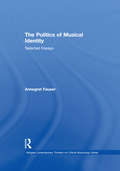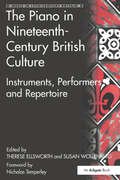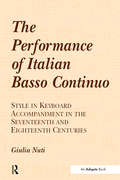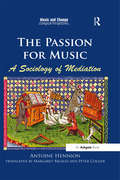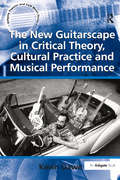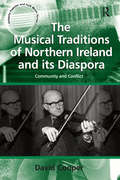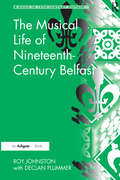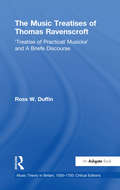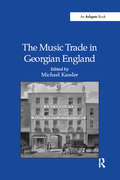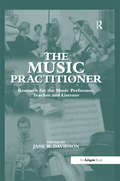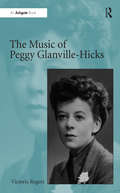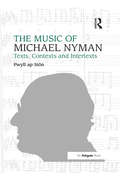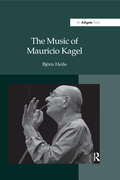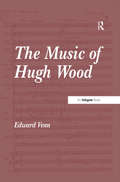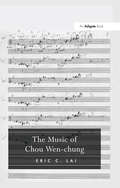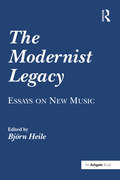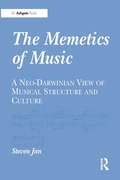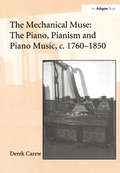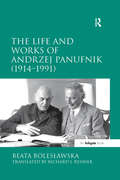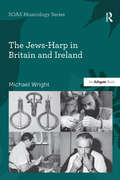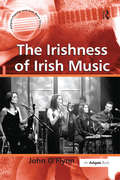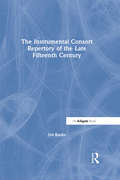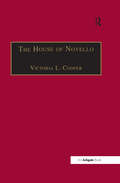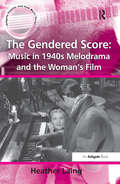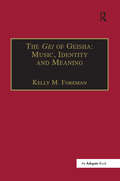- Table View
- List View
The Politics of Musical Identity: Selected Essays (Ashgate Contemporary Thinkers On Critical Musicology)
by Annegret FauserThis volume explores the way in which composers, performers, and critics shaped individual and collective identities in music from Europe and the United States from the 1860s to the 1950s. Selected essays and articles engage with works and their reception by Richard Wagner, Georges Bizet (in an American incarnation), Lili and Nadia Boulanger, William Grant Still, and Aaron Copland, and with performers such as Wanda Landowska and even Marilyn Monroe. Ranging in context from the opera house through the concert hall to the salon, and from establishment cultures to counter-cultural products, the main focus is how music permits new ways of considering issues of nationality, class, race, and gender. These essays - three presented for the first time in English translation - reflect the work in both musical and cultural studies of a distinguished scholar whose international career spans the Atlantic and beyond.
The Piano in Nineteenth-Century British Culture: Instruments, Performers and Repertoire (Music In Nineteenth-century Britain Ser.)
by THERESE ELLSWORTH and SUSAN WOLLENBERGSince the publication of The London Pianoforte School (ed. Nicholas Temperley) twenty years ago, research has proliferated in the area of music for the piano during the late eighteenth and nineteenth centuries and into developments in the musical life of London, for a time the centre of piano manufacturing, publishing and performance. But none has focused on the piano exclusively within Britain. The eleven chapters in this volume explore major issues surrounding the instrument, its performers and music within an expanded geographical context created by the spread of the instrument and the growth of concert touring. Topics covered include: the piano trade and how piano manufacturing affected a major provincial town; the reception of Bach's Well-Tempered Clavier and Clementi's Gradus ad Parnassum during the nineteenth century; the shift from composer-pianists to pianist-interpreters in the first half of the century that triggered crucial changes in piano performance and concert structure; the growth of musical life in the peripheries outside major musical centres; the pianist as advocate for contemporary composers as well as for historical repertory; the status of British pianists both in relation to foreigners on tour in Britain and as welcomed star performers in outposts of the Empire; marketing forces that had an impact on piano sales, concerts and piano careers; leading virtuosos, writers and critics; the important role played by women pianists and the development of the recording industry, bringing the volume into the early twentieth century.
The Performance of Italian Basso Continuo: Style in Keyboard Accompaniment in the Seventeenth and Eighteenth Centuries
by Giulia NutiBasso continuo accompaniment calls upon a complex tapestry of harmonic, rhythmic, compositional, analytical and improvisational skills. The evolving knowledge that underpinned the performance of basso continuo was built up and transmitted from the late 1500s to the second half of the eighteenth century, when changes in instruments together with the assertion of control by composers over their works brought about its demise. By tracing the development of basso continuo over time and across the regions of Italy where differing practices emerged, Giulia Nuti accesses this body of musical usage. Sources include the music itself, introductions and specific instructions and requirements in song books and operas, contemporary accounts of performances and, in the later period of basso continuo, description and instruction offered in theoretical treatises. Changes in instruments and instrumental usage and the resulting sounds available to composers and performers are considered, as well as the altering relationship between the improvising continuo player and the composer. Extensive documentation from both manuscript and printed sources, some very rare and others better known, in the original language, followed by a precise English translation, is offered in support of the arguments. There are also many musical examples, transcribed and in facsimile. Giulia Nuti provides both a scholarly account of the history of basso continuo and a performance-driven interpretation of how this music might be played.
The Passion for Music: A Sociology Of Mediation (Music And Change: Ecological Perspectives Ser.)
by Antoine HennionMusic is an accumulation of mediators: instruments, languages, sheets, performers, scenes, media and so on. There is no musical objectin itself ; music must always be made again. In this innovative book, Hennion turns the elusiveness of music into a resource for a pragmatic analysis: by which collective process do we make music appear among us? Rather than offering a sociology of music, The Passion for Music listens to the lesson provided by the case of music - this art of infinite mediations. Learning from music allows us to transform the paradigm to be offered by sociology, by confronting it (from Durkheim and Weber to Bourdieu) with a different way of considering objects. For this task, Hennion draws on aesthetics (Adorno) and art history (Haskell, Baxandall), as well as science and technology studies and popular music studies (Latour, Frith, DeNora). As part of that project, The Passion for Music presents a wide-ranging series of case studies, restoring attention to the rich and varied intermediaries through which music is brought to life: from the debate around the reinterpretation of baroque music, to the classroom, the rock scene, the classical music concert, Bach‘s ‘social career in the nineteenth and twentieth centuries, and the practices of musicamateurs today. This is the first English translation of one of the most important works of French scholarship on music and society.
The New Guitarscape in Critical Theory, Cultural Practice and Musical Performance (Ashgate Popular And Folk Music Ser.)
by Kevin DaweIn The New Guitarscape, Kevin Dawe argues for a re-assessment of guitar studies in the light of more recent musical, social, cultural and technological developments that have taken place around the instrument. The author considers that a detailed study of the guitar in both contemporary and cross-cultural perspectives is now absolutely essential and that such a study must also include discussion of a wide range of theoretical issues, literature, musical cultures and technologies as they come to bear upon the instrument. Dawe presents a synthesis of previous work on the guitar, but also expands the terms by which the guitar might be studied. Moreover, in order to understand the properties and potential of the guitar as an agent of music, culture and society, the author draws from studies in science and technology, design theory, material culture, cognition, sensual culture, gender and sexuality, power and agency, ethnography (real and virtual) and globalization. Dawe presents the guitar as an instrument of scientific investigation and part of the technology of globalization, created and disseminated through corporate culture and cottage industry, held close to the body but taken away from the body in cyberspace, and involved in an enormous variety of cultural interactions and political exchanges in many different contexts around the world. In an effort to understand the significance and meaning of the guitar in the lives of those who may be seen to be closest to it, as well as providing a critically-informed discussion of various approaches to guitar performance, technologies and techniques, the book includes discussion of the work of a wide range of guitarists, including Robert Fripp, Kamala Shankar, Newton Faulkner, Lionel Loueke, Sharon Isbin, Steve Vai, Bob Brozman, Kaki King, Fred Frith, John 5, Jennifer Batten, Guthrie Govan, Dominic Frasca, I Wayan Balawan, Vicki Genfan and Hasan Cihatter.
The Musical Traditions of Northern Ireland and its Diaspora: Community and Conflict (Ashgate Popular And Folk Music Ser.)
by David CooperFor at least two centuries, and arguably much longer, Ireland has exerted an important influence on the development of the traditional, popular and art musics of other regions, and in particular those of Britain and the United States. During the past decade or so, the traditional musics of the so-called Celtic regions have become a focus of international interest. The phenomenal success of shows such as Riverdance (which appeared in 1995, spawned from a 1994 Eurovision Song Contest interval act) brought Irish music and dance to a global audience and played a part in the further commoditization of Irish culture, including traditional music. However, there has been until now, relatively little serious musicological study of the traditional music of Northern Ireland. Northern Ireland remains a divided community in which traditional culture, in all its manifestations, is widely understood as a marker of religious affiliation and ethnic identity. Since the outbreak of the most recent 'troubles' around 1968, the borders between the communities have often been marked by music. For example, many in the Catholic, nationalist community, regard the music of Orange flute bands and Lambeg drums as a source of intimidation. Equally, many in the Protestant community have distanced themselves from Irish music as coming from a different ethnic tradition, and some have rejected tunes, styles and even instruments because of their association with the Catholic community and the Irish Republic. Of course, during the same period many other Protestants and Catholics have continued to perform in an apolitical context and often together, what in earlier times would simply have been regarded as folk or country music. With the increasing espousal of a discrete Ulster Scots tradition since the signing of the Belfast (or 'Good Friday') Agreement in 1998, the characteristics of the traditional music performed in Northern Ireland, and the place of Protestant musicians within popular Irish cult
The Musical Life of Nineteenth-Century Belfast (Music In Nineteenth-century Britain Ser.)
by Roy JohnstonRoy Johnston and Declan Plummer provide a refreshing portrait of Belfast in the nineteenth century. Before his death Roy Johnston, had written a full draft, based on an impressive array of contemporary sources, with deep and detailed attention especially to contemporary newspapers. With the deft and sensitive contribution of Declan Plummer the finished book offers a telling view of Belfast‘s thriving musical life. Largely without the participation and example of local aristocracy, nobility and gentry, Belfast‘s musical society was formed largely by the townspeople themselves in the eighteenth century and by several instrumental and choral societies in the nineteenth century. As the town grew in size and developed an industrial character, its townspeople identified increasingly with the large industrial towns and cities of the British mainland. Efforts to place themselves on the principal touring circuit of the great nineteenth-century concert artists led them to build a concert hall not in emulation of Dublin but of the British industrial towns. Belfast audiences had experienced English opera in the eighteenth century, and in due course in the nineteenth century they found themselves receiving the touring opera companies, in theatres newly built to accommodate them. Through an energetic groundwork revision of contemporary sources, Johnston and Plummer reveal a picture of sustained vitality and development that justifies Belfast‘s prominent place the history of nineteenth-century musical culture in Ireland and more broadly in the British Isles.
The Music Treatises of Thomas Ravenscroft: 'Treatise of Practicall Musicke' and A Briefe Discourse (Music Theory In Britain, 1500-1700: Critical Editions Ser.)
by RossW. DuffinThomas Ravenscroft is best-known as a composer of rounds owing to his three published collections: Pammelia and Deuteromelia (both 1609), and Melismata (1611), in addition to his harmonizations of the Whole Booke of Psalmes (1621) and his original sacred works. A theorist as well as a composer and editor, Ravenscroft wrote two treatises on music theory: the well-known A Briefe Discourse (1614), and 'A Treatise of Practicall Musicke' (c.1607), which remains in manuscript. This is the first book to bring together both theoretical works by this important Jacobean musician and to provide critical studies and transcriptions of these treatises. A Briefe Discourse furthermore introduces an anthology of music by Ravenscroft, John Bennet, and Ravenscroft's mentor, Edward Pearce, illustrating some of the precepts in the treatise. The critical discussion provided by Duffin will help explain Ravenscroft's complicated consideration of mensuration, in particular.
The Music Trade in Georgian England: Musical Instruments And Printed Music
by Michael KasslerIn contrast to today's music industry, whose principal products are recorded songs sold to customers round the world, the music trade in Georgian England was based upon London firms that published and sold printed music and manufactured and sold instruments on which this music could be played. The destruction of business records and other primary sources has hampered investigation of this trade, but recent research into legal proceedings, apprenticeship registers, surviving correspondence and other archived documentation has enabled aspects of its workings to be reconstructed. The first part of the book deals with Longman & Broderip, arguably the foremost English music seller in the late eighteenth century, and the firm's two successors - Broderip & Wilkinson and Muzio Clementi's variously styled partnerships - who carried on after Longman & Broderip's assets were divided in 1798. The next part shows how a rival music seller, John Bland, and his successors, used textual and thematic catalogues to advertise their publications. This is followed by a comprehensive review of the development of musical copyright in this period, a report of efforts by a leading inventor, Charles 3rd Earl Stanhope, to transform the ways in which music was printed and recorded, and a study of Georg Jacob Vollweiler's endeavour to introduce music lithography into England. The book should appeal not only to music historians but also to readers interested in English business history, publishing history and legal history between 1714 and 1830.
The Music Practitioner: Research for the Music Performer, Teacher and Listener
by JaneW. DavidsonUseful work has been done in recent years in the areas of music psychology, philosophy and education, yet this is the first book to provide a wide assessment of what practical benefits this research can bring to the music practitioner. With 25 chapters by writers representing a broad range of perspectives, this volume is able to highlight many of the potential links between music research and practice. The chapters are divided into five main sections. Section one examines practitioners use of research to assist their practice and the ways in which they might train to become systematic researchers. Section two explores research centred on perception and cognition, while section three looks at how practitioners have explored their everyday work and what this reveals about the creative process. Section four focuses on how being a musician affects an individual‘s sense of self and the how others perceive him or her. The essays in section five outline the new types of data that creative researchers can provide for analysis and interpretation. The concluding chapter discusses that key question - what makes music affect us in the way it does? The research findings in each chapter provide useful sources of data and raise questions that are applicable across the spectrum of music-related disciplines. Moreover, the research methodologies applied to a specific question may have broader application for readers wishing to take on research themselves.
The Music of Peggy Glanville-Hicks
by Victoria RogersPeggy Glanville-Hicks (1912-1990) is an Australian composer whose full significance has only recently been appreciated. Born in Melbourne, Australia, she transcended the gendered expectations of her upbringing and went on to become a fine composer and a highly influential figure in the vibrant musical life of New York after the Second World War. Following early composition studies with Fritz Hart in Melbourne, Glanville-Hicks moved to London where she studied with Ralph Vaughan Williams, then to Paris where she was taught by the great pedagogue, Nadia Boulanger. Her migration to the USA in 1941 shaped the musical direction of her late works. After a brief neoclassical phase, she joined the small group of American composers who were using non-Western musics as their inspirational well-spring, including Colin McPhee, Alan Hovhaness, Lou Harrison and Paul Bowles. During this period she also forged an illustrious career as a music journalist and arts administrator, working tirelessly to promote new music and the careers of young composers. In the late 1950s she retreated to Greece to write 'the big works', most notably the operas which lie at the heart of her creative output. Her compositional career ended prematurely, and tragically, in 1967 following surgery the previous year for a life-threatening brain tumour. Against all medical expectations she went on to live for a further 24 years, returning to Australia in 1975 amidst a dawning recognition that one of the country's most significant composers had returned. Glanville-Hicks's career as a composer is impressive by any measure. She produced over 70 finely-crafted works, including operas, ballets, concertos, instrumental chamber pieces, songs and choral works. The story of her life has been told in the biographies. This book traces the development of her musical language from the English pastoral style of the early works, through the neoclassicism of the middle period, to the melody-rhythm concept of the late works,
The Music of Michael Nyman: Texts, Contexts and Intertexts
by Pwyll ap SiônNyman's rise to international prominence during the last three decades has made him one of the world's most successful living composers. His music has nevertheless been criticized for its parasitic borrowing of other composers' ideas and for its relentless self-borrowing. In this first book-length study in English, Pwyll ap Si laces Nyman's writings within the general context of Anglo-American experimentalism, minimalism and post-minimalism, and provides a series of useful contexts from which controversial aspects of Nyman's musical language can be more clearly understood and appreciated. Drawing upon terms informed by intertextual theory in general, appropriation and borrowing are first introduced within the context of twentieth-century art music and theory. Intertextual concepts are explained and their terms defined before Nyman's musical language is considered in relation to a series of intertextual classifications and types. These types then form the basis of a more in-depth study of his works during the second half of the book, ranging from opera and chamber music to film. Rather than restricting style and technique, Nyman's intertextual approach, on the contrary, is shown to provide his music with an almost infinite amount of variety, flexibility and diversity, and this has been used to illustrate a wide range of technical, aesthetic and expressive forms. He composes with his ear towards the past as if it were a rich quarry to mine, working like a musical archaeologist, uncovering artefacts and chiselling fresh and vibrant sonic edifices out of them.
The Music of Mauricio Kagel
by Bj HeileMauricio Kagel was undoubtedly one of the major figures in the new music of the last fifty years. Growing up in the rich cultural atmosphere of Buenos Aires in the 1940s and '50s, where the writer Jorge Luis Borges was one of his teachers, he became a member of avant-garde circles as well as receiving a rigorous musical education. By 1957 Kagel had acted on the advice of Pierre Boulez to move to Europe to pursue a career as a composer. He quickly established himself at Cologne, the rallying point for young composers at the time, and became one of the leading, if controversial, figures at the famous Darmstadt summer courses. He embraced multiple serialism, aleatory technique and electronics, but he is best known for his pioneering explorations in music theatre, radio play, film and mixed media. Bj rn Heile charts Kagel's compositional development, considering the aesthetic and ideological issues the composer raises in his work. Focusing on Kagel's use of music as a means of intellectual inquiry, Heile shows Kagel to constantly question the nature of music and its role in society. Kagel's broadening of the concept of music to include theatre, film and other media, his disdain for purism as well as his subversive humour and sense of the absurd have challenged reified notions of music and art. Heile considers Kagel's background as Argentine immigrant to Europe (born to Russian-Jewish immigrants to Argentina) to situate the composer's aesthetic. What emerges is the breadth of Kagel's imagination and the multiplicity of contexts he drew from, which were both distinctive and, in the age of pluralist multiculturalism and globalization, exemplary. As Heile demonstrates, it was Kagel's enlarged notion of music as inherently multimedial that may be his most important contribution to new music, and on which his reputation ultimately rests.
The Music of Hugh Wood
by Edward VennThe Music of Hugh Wood provides the first ever in-depth study of this well-known, yet only briefly documented composer. Over the years, Wood (b. 1932) has produced a sizeable oeuvre that explores the established genres of symphony, concerto, and quartet on the one hand, and songs and choruses on the other. Underpinned by an awareness of recent philosophical, theoretical and analytical concepts, Dr Edward Venn highlights both the technical basis of Wood's music and the expressive force of his work. In doing so, a picture emerges of Wood as an artist of considerable merit and power. The eclectic blend of national and international influences in the music of Hugh Wood combine to create an individual and distinctive musical language all his own. The book provides an overview of Wood's style, focussing on his engagement with modernism and the melodic, rhythmic, harmonic and formal characteristics of his musical language. From here a more detailed consideration of Wood's development as a composer is advanced, in which his technical development is illustrated alongside an exploration of various aspects of musical meaning embodied in his works. In the process, numerous analytical strategies ranging from formalist to narrative structures are utilized, demonstrating the fecundity and expressivity of Wood's music.
The Music of Chou Wen-chung
by EricC. LaiChou Wen-chung is one of the most influential musical figures of our time. His rich cultural background, his studies with Edgard Var and his interest in the genuine rapport between Eastern and Western musical traditions have been the major influences on his career. Although he is active in various artistic and cultural circles that include scholarship, education and cultural preservation, his major calling has always been composition. As a composer, Chou has created a group of works whose stylistic innovation and technical profundity are distinctive among composers of his generation. His music, which has received critical acclaim around the globe, documents his creative journey, especially in the realization of re-merger - the fusion of Eastern and Western music that has become a new mainstream in art music. Through extensive focus on sketch study, Eric Lai examines Chou's music to contribute to an understanding of his aesthetic orientation, his compositional technique, his role in the development of new music, and his influence upon the younger generation of composers.
The Modernist Legacy: Essays on New Music
by Björn HeileThis collection of essays offers a historical reappraisal of what musical modernism was, and what its potential for the present and future could be. It thus moves away from the binary oppositions that have beset twentieth-century music studies in the past, such as those between modernism and postmodernism, between conceptions of musical autonomy and of cultural contingency and between formalist-analytical and cultural-historical approaches. Focussing particularly on music from the 1970s to the 1990s, the volume assembles approaches from different perspectives to new music with a particular emphasis on a critical reassessment of the meaning and function of the legacy of musical modernism. The authors include scholars, musicologists and composers who combine culturally, socially, historically and aesthetically oriented approaches with analytical methods in imaginative ways.
The Memetics of Music: A Neo-Darwinian View of Musical Structure and Culture
by Steven JanRichard Dawkins's formulation of the meme concept in his 1976 classic The Selfish Gene has inspired three decades of work in what many see as the burgeoning science of memetics. Its underpinning theory proposes that human culture is composed of a multitude of particulate units, memes, which are analogous to the genes of biological transmission. These cultural replicators are transmitted by imitation between members of a community and are subject to mutational-evolutionary pressures over time. Despite Dawkins and several others using music in their exemplifications of what might constitute a meme, these formulations have generally been quite rudimentary, even na. This study is the first musicologically-orientated attempt systematically to apply the theory of memetics to music. In contrast to the two points of view normally adopted in music theory and analysis - namely those of the listener and the composer - the purpose of this book is to argue for a distinct and illuminating third perspective. This point of view is metaphorical and anthropomorphic, and the metaphor is challenging and controversial, but the way of thinking adopted has its basis in well-founded scientific principles and it is capable of generating insights not available from the first two standpoints. The perspective is that of the (selfish) replicated musical pattern itself, and adopting it is central to memetics. The approach taken is both theoretical and analytical. Starting with a discussion of evolutionary thinking within musicology, Jan goes on to cover the theoretical aspects of the memetics of music, ranging from quite abstract philosophical speculation to detailed consideration of what actually constitutes a meme in music. In doing so, Jan draws upon several approaches current in music theory, including Schenkerism and Narmour's implication-realization model. To demonstrate the practical utility of the memetic perspective, Chapter 6 applies it analytically, tracing the transmission o
The Mechanical Muse: The Piano, Pianism and Piano Music, c.1760-1850
by Derek CarewThis book charts the piano's accession from musical curiosity to cultural icon, examining the instrument itself in its various guises as well as the music written for it. Both the piano and piano music were very much the product of the intellectual, cultural and social environments of the period and both were subject to many influences, directly and indirectly. These included character (individualism), the vernacular ('folk/popular') and creativity (improvisation), all of which are discussed generally and with respect to the music itself. Derek Carew surveys the most important pianistic genres of the period (variations, rondos, and so on), showing how these changed from their received forms into vehicles of Romantic expressiveness. The piano is also looked at in its role as an accompanying instrument. The Mechanical Muse will be of interest to anyone who loves the piano or the period, from the non-specialist to the music postgraduate.
The Life and Works of Andrzej Panufnik (1914-1991)
by Beata Boles?awskaSir Andrzej Panufnik was born in Warsaw and studied in the newly independent Poland in the 1930s, as well as in Vienna and Paris just before the outbreak of the Second World War. During the German occupation he formed a piano duo with his friend and fellow composer Witold Lutoslawski, and they performed in caf�around Warsaw. After the war, Panufnik quickly established himself as a leading Polish composer, and as a conductor he played a significant role in the re-establishment of first the Krak�nd then the Warsaw Philharmonic. Although he was considered Poland�s leading composer for some years after the war, Panufnik was subsequently put under intolerable pressure both musically and politically. Frustrated by the continuing rejection of his compositions and the unending political demands inflicted on him by the country�s post-war Communist regime, he made a daring escape to England in 1954. He briefly became Principal Conductor of the City of Birmingham Symphony Orchestra, a post he relinquished after two years to devote all his time to composition. His works were in demand by major figures such as Leopold Stokowski who conducted the first performances of Sinfonia Elegiaca, Katyn Epitaph and Universal Prayer, Yehudi Menuhin who commissioned the Violin Concerto, Seiji Ozawa in Boston and Sir Georg Solti in Chicago who both commissioned symphonies for the centenaries of their famous orchestras; also Mstislav Rostropovich with the London Symphony Orchestra, who together commissioned the Cello Concerto. Beata Boleslawska has written the first book on the life and artistic output of Panufnik, setting his significance alongside the political and cultural scene of twentieth-century Europe. The account of the composer�s life is based on numerous archival documents, as well as the personal accounts contributed by his family and friends. Panufnik�s compositional style and techniques are also analysed. This book will be of interest not only to those devoted
The Jews-Harp in Britain and Ireland (Soas Studies In Music Ser.)
by Michael WrightThe jews-harp is a distinctive musical instrument of international importance, yet it remains one of those musical instruments, like the ocarina, kazoo or even the art of whistling, that travels beneath the established musical radar. The story of the jews-harp is also part of our musical culture, though it has attracted relatively little academic study. Britain and Ireland played a significant role in the instrument�s manufacture and world distribution, particularly during the nineteenth and first half of the twentieth centuries. Drawing upon previously unknown written sources and piecing together thousands of fragments of information spanning hundreds of years, Michael Wright tells the story of the jews-harp�s long history in the Britain and Ireland. Beginning with an introductory chapter describing the instrument, Part One looks at the various theories of its ancient origin, how it came to be in Europe, terminology, and its English name. Part Two explores its commercial exploitation and the importance of the export market in the development of manufacturing. Part Three looks the instrument�s appearance and use in art, literature and the media, finally considering the many players who have used the instrument throughout its long history.
The Irishness of Irish Music
by John O'FlynnThis book brings together important material from a range of sources and highlights how government organizations, musicians, academics and commercial companies are concerned with, and seek to use, a particular notion of Irish musical identity. Rooting the study in the context of the recent history of popular, traditional and classical music in Ireland, as well as providing an overview of aspects of the national field of music production and consumption, O'Flynn goes on to argue that the relationship between Irish identity and Irish music emerges as a contested site of meaning. His analysis exposes the negotiation and articulation of civic, ethnic and economic ideas within a shifting hegemony of national musical culture, and finds inconsistencies between and among symbolic constructions of Irish music and observed patterns in the domestic field. More specifically, O'Flynn illustrates how settings, genres, social groups and values can influence individual identifications or negations of Irishness in music. While the apprehension of intra-musical elements leads to perceptions of music that sounds Irish, style and authenticity emerge as critical articulatory principles in the identification of music that feels Irish. The celebratory and homogenizing discourse associated with the international success of some Irish musical forms is not reflected in the opinions of the people interviewed by O'Flynn; at the same time, an insider/outsider dialectic of national identity is found in various forms of discourse about Irish music. Performers and composers discussed include Bill Whelan (Riverdance), Sinead O'Connor, The Corrs, Altan, U2, Martin Hayes, Dolores Keane and Gerald Barry.
The Instrumental Consort Repertory of the Late Fifteenth Century
by Jon BanksThough individual pieces from the late fifteenth century are widely accepted as being written for instruments rather than voices, they are traditionally considered as exceptions within the context of a mainstream of vocal polyphony. After a rigorous examination of the criteria by which music of this period may be judged to be instrumental, Dr Jon Banks isolates all such pieces and establishes them as an explicit genre alongside the more commonly recognized vocal forms of the period. The distribution of these pieces in the manuscript and early printed sources of the time demonstrate how central instrumental consorts were to musical experience in Italy at this time. Banks also explores the social background to Italian music-making, and particularly the changing status of instrumentalists with respect to other musicians. Convincing evidence is put forward in particular for the lute ensemble to be a likely performance context for many of the surviving sources. The book is not intended to be a prescriptive account for the role of instruments in late medieval music, but instead restores an impressive but largely overlooked consort repertory to its rightful place in the history of music.
The House of Novello: Practice and Policy of a Victorian Music Publisher, 1829-1866 (Music In Nineteenth-century Britain Ser.)
by VictoriaL. CooperBy the mid-nineteenth century music publishing was no longer the provenance of shopkeepers, instrument makers or individual scholars, but a business enterprise undertaken by a new breed of Victorian entrepreneur. Two such were Vincent Novello and his son Alfred, whose music publishing house enjoyed significant growth between 1829 and 1866. Victoria Cooper builds up a picture of Novello during this period and the socio-economic and cultural climate that influenced the company's business decisions. Looking in detail at some of the editions Novello published, she analyzes the editing style of the firm and how this was dictated by Novello's main audience of amateur musicians and choral societies. Scrutiny of Novello's stockbook indicates the financial fortunes of these editions, while correspondence between the firm and composers such as Mendelssohn reveals how Vincent and Alfred went about acquiring new compositions. With its focus on the development of a music publishing business, this study brings a fresh dimension to musicological research. Novello was able to combine business practice with a commitment to disseminate music of educational and artistic value, and the history of the company provides illuminating evidence of the commodification of music in nineteenth-century Britain.
The Gendered Score: Music in 1940s Melodrama and the Woman's Film (Ashgate Popular And Folk Music Ser.)
by Heather LaingHeather Laing examines, for the first time, the issues of gender and emotion that underpin the classical style of film scoring, but that have until now remained unquestioned and untheorized, thus providing a benchmark for thinking on more recent and alternative styles of scoring. Many theorists have discussed this type of music in film as a signifier of emotion and 'the feminine', a capacity in which it is frequently associated with female characters. The full effect of such an association on either female or male characterization, however, has not been examined. This book considers the effects of this association by progress through three stages: cultural-historical precedents, the generic parameters of melodrama and the woman's film, and the narrativization of music in film through diegetic performance and the presence of musicians as characters. Case studies of specific films provide textual and musical analyses, and the genres of melodrama and the woman's film have been chosen as representative not only of the epitome of the Hollywood scoring style, but also of the narrative association of women, emotion and music. Laing leads to the conclusion that music functions as more than merely a signifier of emotion. Rather, it takes a crucial role in both indicating and determining how emotion is actually understood as part of the construction of gender and its representation in film.
The Gei of Geisha: Music, Identity and Meaning (Soas Studies In Music Ser.)
by KellyM. ForemanThe Japanese geisha is an international icon, known almost universally as a symbol of traditional Japan. Numerous books exist on the topic, yet this is the first to focus on the 'gei' of geisha - the art that constitutes their title (gei translates as fine art, sha refers to person). Kelly M. Foreman brings together ethnomusicological field research, including studying and performing the shamisen among geisha in Tokyo, with historical research. The book elaborates how musical art is an essential part of the identity of the Japanese geisha rather than a secondary feature, and locates current practice within a tradition of two and half centuries. The book opens by deconstructing the idea of 'geisha' as it functions in Western societies in order to understand why gei has been, and continues to be, neglected in geisha studies. Subsequent chapters detail the myriad musical genres and traditions with which geisha have been involved during their artistic history, as well as their position within the traditional arts society. Considering the current situation more closely, the final chapters explore actual dedication to art today by geisha, and analyse how they create impromptu performances at evening banquets. An important issue here is geisha-patron artistic collaboration, which leads to consideration of what Foreman argues to be the unique and essential nexus of identity, eroticism and aesthetics within the geisha world.
